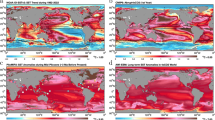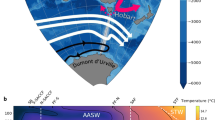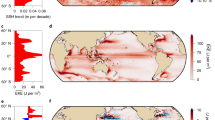Abstract
The spatial distributions of certain sea-surface properties, such as temperature, fluctuate on timescales from months to decades and in synchrony with the main regional atmospheric patterns comprising the global climate system1. Although it has long been assumed that the ocean is submissive to the dictates of the atmosphere, recent studies raise the possibility of an assertive, not merely passive, oceanic role in which water-mass circulation controls the timescales of climate fluctuations2,3,4,5,6. Previously held notions of the immutability of the physical and chemical characteristics of deep water masses are changing as longer time series of ocean measurements indicate that the signatures of varying sea-surface conditions are translated to deep waters4,7. Here we use such time-series measurements to track signals ‘imprinted’ at the sea surface in the North Atlantic Ocean's subpolar Labrador Basin into the deep water of the subtropical basins near Bermuda, and infer an approximately 6-year transit time. We establish a geographic and temporal context for a portion of the long-term warming trend reported for mid-depth subtropical waters over the past 40 or so years8,9, and we predict that waters at these depths will continue to cool well into the next decade.
This is a preview of subscription content, access via your institution
Access options
Subscribe to this journal
Receive 51 print issues and online access
$199.00 per year
only $3.90 per issue
Buy this article
- Purchase on Springer Link
- Instant access to full article PDF
Prices may be subject to local taxes which are calculated during checkout



Similar content being viewed by others
References
Deser, C. & Blackmon, M. Surface climate variations over the North Atlantic Ocean during winter: 1900–1989. J. Clim. 6, 1743–1753 (1993).
Kushnir, Y. & Held, I. M. Equilibrium atmospheric response to North Atlantic SST anomalies. J. Clim. 9, 1208–1220 (1996).
Griffies, S. M. & Bryan, K. Apredictability study of simulated North Atlantic multidecadal variability. Clim. Dyn. 13(7/8), 459–487 (1997).
Dickson, B. From the Labrador Sea to global change. Nature 386, 649–650 (1997).
Sutton, R. T. & Allen, M. R. Decadal predictability of North Atlantic Sea surface temperature and climate. Nature 388, 563–565 (1997).
McCartney, M. S. Is the ocean at the helm? Nature 388, 521–522 (1997).
Dickson, R., Lazier, J., Meincke, J., Rhines, P. & Swift, J. Long-term coordinated changes in the convective activity of the North Atlantic. Prog. Oceanogr. 38, 241–295 (1996).
Bryden, H. L. et al. Decadal changes in water mass characteristics at 24° N in the subtropical North Atlantic Ocean. J. Clim. 9, 3162–3186 (1996).
Joyce, T. M. & Robbins, P. The long-term hydrographic record at Bermuda. J. Clim. 9, 3121–3131 (1996).
Roemmich, D. & Wunsch, C. Apparent changes in the climatic state of the deep North Atlantic Ocean. Nature 307, 447–450 (1984).
Levitus, S. Interpentadal variability of temperature and salinity at intermediate depths of the North Atlantic Ocean, 1970–1974 versus 1955–1959. J. Geophys. Res. 94, 6091–6131 (1989).
Houghton, R. W. Subsurface quasi-decadal fluctuations in the North Atlantic. J. Clim. 9, 1363–1373 (1996).
Lazier, J. R. in Natural Climate Variability on Decade-to-Century Time Scales of Natural Climate Variability (ed. Martinson, D. G. et al.) 295–302 (National Academy Press, Washington, DC, 1995).
Hurrell, J. W. Decadal trends in the North Atlantic Oscillation: regional temperatures and precipitation. Science 269, 676–679 (1995).
Dickson, R., Meincke, J., Malmberg, S.-A. & Lee, A. The “Great Salinity Anomaly” in the northern North Atlantic 1968–1982. Prog. Oceanogr. 20, 103–151 (1988).
Belkin, I. M., Levitus, S. & Antonov, J. “Great Salinity Anomalies” in the North Atlantic. Prog. Oceanogr. (in the press).
Talley, L. D. & McCartney, M. S. Distribution and circulation of Labrador Sea Water. J. Phys. Oceanogr. 12, 1189–1205 (1982).
Sy, A. et al. Surprisingly rapid spreading of newly formed intermediate waters across the North Atlantic Ocean. Nature 386, 675–679 (1997).
Molinari, R. et al. Fast-track for recently formed Labrador Sea Water: the Deep Western Boundary Current of the North Atlantic Ocean. Deep-Sea Res. (submitted).
Curry, R. HydroBase: a database and tools for climatologic analysis.(Tech. Rep. WHOI-96-01, Woods Hole Oceanographic Inst, 1996).
Acknowledgements
This work was supported by the Atlantic Climate Change Program of NOAA's Climate and Global Change Program and by the National Science Foundaiton.
Author information
Authors and Affiliations
Corresponding author
Rights and permissions
About this article
Cite this article
Curry, R., McCartney, M. & Joyce, T. Oceanic transport of subpolar climate signals to mid-depth subtropical waters. Nature 391, 575–577 (1998). https://doi.org/10.1038/35356
Received:
Accepted:
Issue Date:
DOI: https://doi.org/10.1038/35356
This article is cited by
-
Decadal changes in Atlantic overturning due to the excessive 1990s Labrador Sea convection
Nature Communications (2023)
-
North Atlantic gyre circulation in PRIMAVERA models
Climate Dynamics (2021)
-
Subpolar North Atlantic western boundary density anomalies and the Meridional Overturning Circulation
Nature Communications (2021)
-
Reconciling roles of sulphate aerosol forcing and internal variability in Atlantic multidecadal climate changes
Climate Dynamics (2019)
-
Recent Progress in Understanding and Predicting Atlantic Decadal Climate Variability
Current Climate Change Reports (2017)
Comments
By submitting a comment you agree to abide by our Terms and Community Guidelines. If you find something abusive or that does not comply with our terms or guidelines please flag it as inappropriate.



